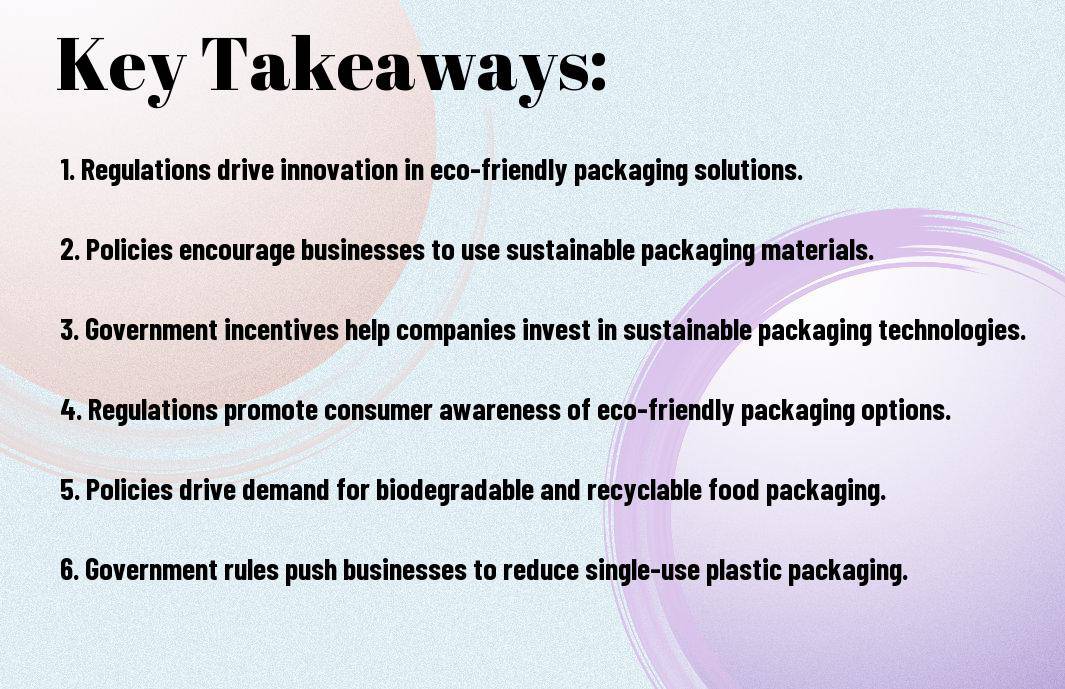Are you aware of how government regulations and policies can significantly influence the adoption of eco-friendly food packaging? Understanding the impact of legislation on packaging choices is essential for businesses in the food industry. You may be surprised to learn that government regulations and policies can either facilitate or hinder the transition to more sustainable packaging options. To understand this further, let’s delve into the role of Packaging and Environmental Legislation in the United States and its impact on the adoption of eco-friendly food packaging.
Key Takeaways:
- Government regulations play a crucial role in driving the adoption of eco-friendly food packaging by setting standards and requirements for packaging materials and processes.
- Policies that provide incentives, such as tax breaks or grants, can encourage businesses to invest in eco-friendly alternatives and foster innovation in sustainable packaging solutions.
- Collaboration between government, businesses, and consumers is essential for creating a sustainable and efficient food packaging system that minimises environmental impact.

The Role of Government in Environmental Strategy
When it comes to promoting eco-friendly food packaging, the role of government cannot be overstated. Governments play a crucial role in formulating and implementing environmental policies and regulations that directly impact the adoption of sustainable packaging in the food industry. Their actions have a significant influence on the strategies and practices adopted by businesses in this sector.
According to a recent article by Food Logistics, it is important to prepare for the upcoming sustainable packaging regulations anticipated in 2023 as a result of government initiatives.
Legal Framework for Eco-friendly Practices
The legal framework enforced by governments is a key driver in promoting eco-friendly practices within the food packaging industry. Regulations on the use of recyclable materials, restrictions on single-use plastics, and mandates for biodegradable packaging all contribute to creating a more sustainable landscape for food packaging. Adhering to these regulations not only helps you avoid legal repercussions, but it also demonstrates your commitment to environmental responsibility, which can enhance your brand reputation and consumer trust.
Impact of Policies on Food Packaging Industry
The policies implemented by governments have a direct impact on the food packaging industry. By establishing clear guidelines and standards for sustainable packaging, governments incentivise businesses to invest in research and development of eco-friendly materials and technologies. On the flip side, non-compliance or failure to adapt to these policies could result in fines, penalties, and market disadvantage. Therefore, it is crucial for you to stay abreast of the latest policies and regulations, and proactively adjust your packaging strategies to align with these requirements.
The Effects of Regulations on Eco-friendly Food Packaging Adoption
Government regulations play a significant role in shaping the adoption of eco-friendly food packaging. These policies can incentivise businesses to switch to sustainable packaging solutions, while also setting standards and guidelines for what can and cannot be used. This chapter examines the impact of regulations on the adoption of eco-friendly food packaging, including success stories and challenges faced in their implementation.
Case Study: Success Stories due to Regulations
One notable success story is the European Union’s ban on single-use plastics, which has prompted many food businesses to embrace eco-friendly alternatives. This regulation has significantly reduced the amount of plastic waste and encouraged the development of innovative packaging solutions. Furthermore, the introduction of tax incentives for businesses using sustainable packaging has led to a surge in the adoption of biodegradable and compostable materials.
Case Study: Challenges and Barriers in Regulation Implementation
However, the implementation of regulations is not without its challenges. Some businesses have faced difficulties in sourcing affordable eco-friendly packaging options that meet regulatory requirements. Furthermore, there is a risk of manufacturers substituting banned materials with equally harmful alternatives, posing a threat to the environment. Additionally, the lack of standardisation and inconsistency in regulations across different regions can create confusion and hinder widespread adoption of sustainable packaging practices.
Government Policies as a Driving Force for Change
Government regulations and policies play a crucial role in shaping the adoption of eco-friendly food packaging. By implementing strict regulations and offering incentives for sustainable practices, governments can create a significant impact on the industry. These policies can drive businesses to embrace environmentally friendly alternatives and reduce their reliance on traditional, non-biodegradable packaging materials.
Review of Global Best Practices in Eco-friendly Policies
Across the globe, several countries have set strong examples by enacting robust eco-friendly packaging policies. For example, some European countries have imposed stringent restrictions on single-use plastic products and introduced extended producer responsibility schemes. In addition, countries like Japan have taken proactive measures to promote the use of biodegradable packaging materials, while also encouraging innovation in sustainable packaging technologies.
Policy Recommendations for Promoting Eco-friendly Food Packaging
When looking at global best practices, it becomes evident that implementing a combination of policies is the most effective approach. Governments could consider implementing a ban on single-use plastics, investing in research and development of eco-friendly packaging materials, offering tax incentives for sustainable packaging, and creating awareness campaigns to educate consumers about the importance of making environmentally conscious choices. By taking these steps, governments can create a conducive environment for businesses to transition to eco-friendly packaging solutions, ultimately leading to a significant reduction in the environmental impact of food packaging.
Government Regulations and Eco-Friendly Food Packaging
Following this discussion, you can clearly see the significant impact that government regulations and policies have on the adoption of eco-friendly food packaging. Regulations that promote the use of biodegradable materials and policies that discourage the use of harmful substances can greatly influence the choices made by businesses in the food packaging industry. The link between government regulations and the adoption of eco-friendly packaging is crucial in driving the shift towards sustainable practices. To learn more about biodegradable packaging materials for food, you can visit this article.
FAQ
Q: What are government regulations and policies related to eco-friendly food packaging?
A: Government regulations and policies related to eco-friendly food packaging include restrictions on the use of harmful chemicals, requirements for recyclability or compostability, and guidelines for labelling and certification.
Q: How do government regulations and policies promote the adoption of eco-friendly food packaging?
A: Government regulations and policies promote the adoption of eco-friendly food packaging by incentivising businesses to use sustainable materials, providing funding for research and development, and creating standards for environmentally-friendly packaging.
Q: What are the challenges for businesses in complying with government regulations and policies for eco-friendly food packaging?
A: Challenges for businesses in complying with government regulations and policies for eco-friendly food packaging include initial investment costs, sourcing of sustainable materials, and navigating through complex and evolving regulatory frameworks.
Q: How do government regulations and policies impact consumer behaviour towards eco-friendly food packaging?
A: Government regulations and policies impact consumer behaviour towards eco-friendly food packaging by raising awareness about environmental issues, setting expectations for sustainable packaging, and influencing purchasing decisions through eco-labeling and certification.
Q: What are the potential benefits of government regulations and policies on the adoption of eco-friendly food packaging?
A: The potential benefits of government regulations and policies on the adoption of eco-friendly food packaging include reduced environmental impact, improved public health, increased market demand for sustainable products, and a shift towards a more circular economy.

